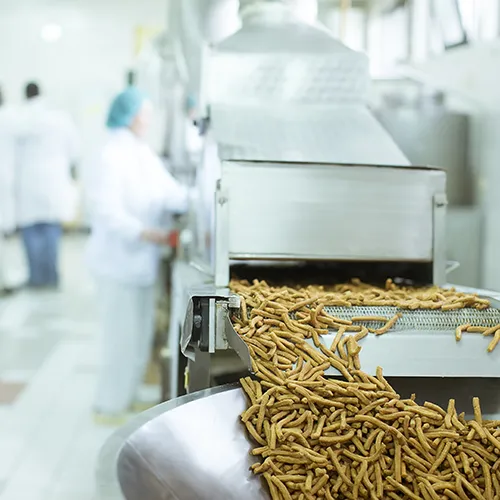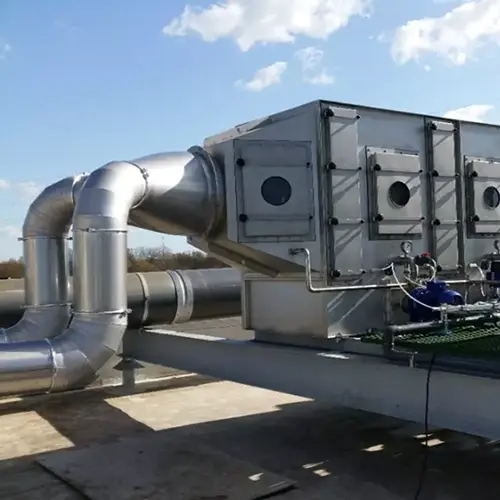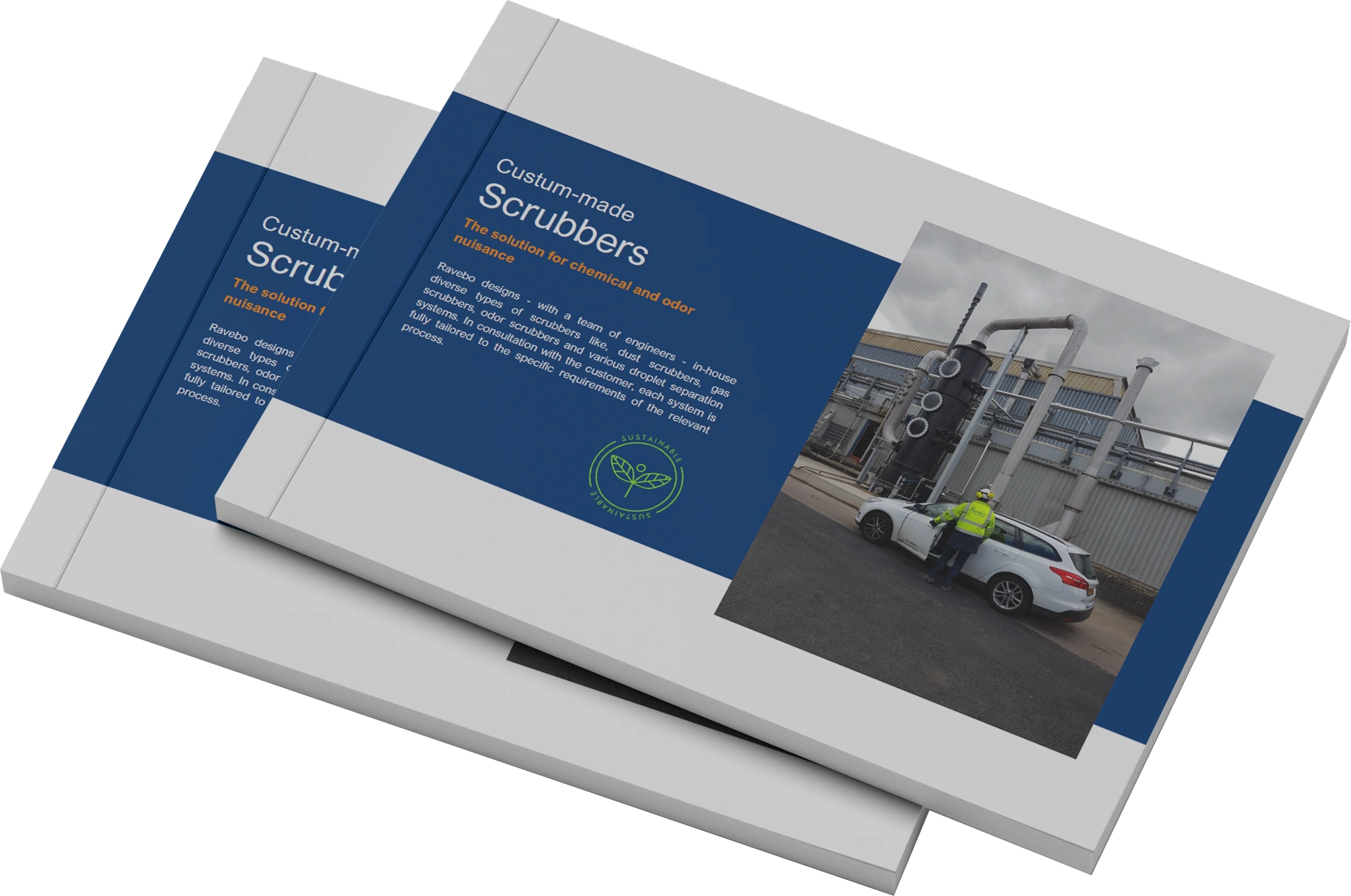
Odor Nuisance and Its Implications in Food Processing
Understanding the Science of Odor Control and Its Impact on Flavor Perception
Customised advise from one of our specialists.
Fill in the form below and we will contact you as soon as possible.

Navigating the Challenges of Odor Emissions in Food Production
Exploring the Intricate Relationship Between Odor Management and Flavor Experience in the Culinary Sector

The emission of unpleasant smells from food industry facilities poses a notable issue, leading to frequent grievances from nearby inhabitants regarding air purity. The manufacturing procedures significantly add to the release of odor-causing substances such as aldehydes, amines, mercaptans and VOC’s. To assess the olfactory air conditions in the vicinity of such operations, dispersion modeling of pollutants, specifically odors or odorants, is commonly employed.
Flavor plays a crucial role in determining the overall eating experience of food. It has been proposed that flavor encompasses various factors such as taste, odor, the trigeminal system, touch, as well as visual and auditory cues. This definition aligns well with the ISO definition of flavor, which characterizes it as a complex amalgamation of olfactory, gustatory, and trigeminal sensations experienced during the act of tasting. While taste pertains to the fundamental tastes of sweetness, sourness, saltiness, bitterness, and umami, odor refers to the scent produced by specific volatile compounds. It is widely acknowledged that many food items possess a bland flavor profile with minimal aroma.
Multiple food processes develop odors like:
- fish processing;
- meat processing and slaughterhouses;
- vegetable cooking and fermentation;
- coffee, cocoa beans and peanut roasting;
- potato baking

How Do We Measure and Rate Smell?
Exploring the Factors That Influence Odor Perception and Its Impact

The perception of odors by individuals can be influenced by a variety of factors, including the type of substance emitting the odor, the length of time the individual is exposed to the odor, the specific location where the odor is present, and the individual's own sensitivity to odors. Among these factors, the duration and frequency of exposure, the concentration of the odor, and the perceived olfactory quality (whether the odor is pleasant or unpleasant) are considered to be the most significant. The concept of smell, including terms such as odor, stench, and nuisance, can be difficult to define and quantify. Are there specific definitions that can help us better understand, observe, and measure the impact of odors on individuals?
Get in touch with us

Understanding Odor: Definitions and Impacts
Exploring the Health and Environmental Consequences of Odor Emissions

Odor is a characteristic possessed by a substance that triggers the olfactory sense and has the potential to cause inconvenience and harm to health. Corporations have the ability to release odorous substances into the surrounding environment, which can irritate individuals and result in complaints and negative public perception. These fugitive emissions contribute to air pollution and climate change, while also causing financial losses for the emitting company due to the loss of products. The odor disperses through the air, creating an unpleasant living environment for individuals (emission). When referring to odor nuisance, we are quantifying the amount of odor present in terms of odor units per cubic meter of air that infiltrates people's residences.
Prolonged exposure to odors in the living environment can result in odor nuisance, which may also present health hazards. This nuisance can manifest in physical symptoms like headaches, nausea, breathing difficulties, and irregular heart rate. Additionally, odors can trigger psychological issues such as stress, dissatisfaction with the surroundings, and decreased engagement in outdoor activities. The odor threshold refers to the minimum concentration of a substance required to detect an odor.

Measuring Odor Load: Techniques and Thresholds
Understanding the Precision of Odor Quantification Using Olfactometry

An objective method of measurement is essential for quantifying odor. This method is quantified in European odor units per cubic meter of air (ouE/m³). When utilizing an olfactometer to measure odor, a cohort of individuals is exposed to the odor sample through the air dilution unit of the olfactometer. Initially, the fragrance is significantly diluted until the entire group signals that they are no longer able to detect the scent. Subsequently, the researcher incrementally increases the concentration by slightly decreasing the air dilution and observes the reactions of the panel members. The operator continues to elevate the odor intensity by reducing the air dilution until half of the panel indicates they can perceive the odor, while the other half remains unable to do so.
According to the definition, the dilution point of one unit of odor per cubic meter signifies the point at which 50% of the panel is unable to detect the odor, while the remaining 50% can. This specific dilution point is commonly referred to as the threshold of observation. The operator sums up all the dilutions necessary to reach this threshold in order to determine the number of odor units present in the original sample once the observation threshold has been surpassed.
Black carbon is a constituent of fine particulate matter air pollution, which is the primary environmental factor contributing to adverse health effects and untimely mortality. Due to their minuscule size, these particles possess the ability to deeply penetrate the respiratory system, thereby facilitating the transportation of harmful substances into the bloodstream. Long-term exposure to particulate air pollution is estimated to cause approximately 4 million deaths annually. Furthermore, air pollution has been associated with various health consequences, including premature mortality in adults suffering from heart and lung diseases, strokes, heart attacks, chronic respiratory ailments like bronchitis, exacerbated asthma, and other cardio-respiratory symptoms. Infants and children are also vulnerable to its detrimental effects, as this form of air pollution is responsible for the untimely demise of children due to acute lower respiratory infections such as pneumonia. Additionally, these particles have been detected in the lungs, livers, and brains of unborn babies, potentially impacting their early childhood development.

Quantifying Odor Annoyance: Impact on Communities
Exploring the Variability of Odor Nuisance and Its Factors

Odor annoyance is commonly quantified as the proportion of individuals affected by odor nuisance (% nuisance). This represents the percentage of individuals who are occasionally or frequently disturbed by a particular smell. Examining the relationship between the intensity of odor nuisance and the percentage of individuals affected by odor nuisance offers a deeper understanding of the issue. However, it is important to note that there is no universal dose-effect relationship that is applicable to all odors and circumstances. The level of odor nuisance experienced can vary depending on factors such as:
- exposure duration
- frequency of exposure
- nature and (un)pleasantness of the smell (hedonic scale)
Game-changing benefits
Discover the game-changing benefits of scrubbers and propel your business forward with our free whitepaper download.

Advancements in Gas Scrubbing Technology for Emission Control
Optimizing Industrial Processes with Efficient Scrubber Systems

Gas scrubbing is a prevalent method employed in the food industry to minimize multiple kinds of gas emissions. It is primarily utilized for substances that are hygroscopic or exhibit high solubility in water. In addition, there are alternative scrubber configurations that, for example, use non-polar washing liquids to effectively remove organic gases. The efficiency of a scrubber can be adjusted to the chemical properties of a particular substance group by dosing chemicals such as acids, alkalines, or oxidizing additives into the washing liquid.
Scrubbers can recover raw materials; however, an extra separation technique is necessary. Moreover, this technique can effectively address odors. The concentration of gas scrubbers greatly varies depending on the application and the dust that needs to be eliminated. In the majority of cases, a gas scrubber can meet the general emission requirement for a specific substance. The fundamental principle behind a scrubber is the absorption of a gas or vapor in a liquid. To achieve this, the waste gas is thoroughly exposed to the washing liquid, typically water with or without additional substances. Scrubbers can recover raw materials and can also reduce water consumption by applying additives; However, an additional separation technique is necessary. In addition, wet gas scrubbers can effectively remove odors. The concentration of scrubbers varies greatly depending on the application and the dust that needs to be removed. In most cases, a scrubber is also the most obvious technique to meet the general emission limits for a specific substance or gas.
A gas scrubber operates on the fundamental principle of absorbing a gas or vapor into a scrubbing liquid. This process is achieved by thoroughly exposing the waste gas to the washing liquid, which can be water (plus additional chemicals) or non-polar washing liquids. The essential components of a gas scrubber include an absorption unit equipped with spray nozzles or contact packings, a pump system with instrumentation, and a recirculation buffertank for the chemical reaction. The effectiveness of scrubbers is primarily determined by factors such as the duration of gas exposure in the absorption unit, the characteristics of the packing material or spray nozzles, the gas-liquid ratio (L/G), the reaction rate, the temperature of the liquid, and the dosage of chemical agents.
Gas scrubbers may also form components of intricate combinations of methods. For instance, these combinations may involve various types of gas scrubbers, such as an acid scrubber and an alkaline scrubber, a neutral scrubber stage linked sequentially to achieve dual effects (multi-stage scrubber).
Gas scrubbers can be designed with multiple sections or columns arranged in a series, known as multi-stage scrubbers. This configuration allows for various chemical reactions to occur in each section, effectively eliminating different components from the gas. Additionally, a scrubber system may comprise several identical sections connected in series, serving the purpose of enhancing overall efficiency.
Get in touch with our scrubber specialist
Our gas scrubbers with analyzing systems make it possible to clean various gas flows. This leads to a cleaner living environment and more sustainable production processes. Curious about the possibilities? Our specialists are happy to provide you with appropriate advice.
